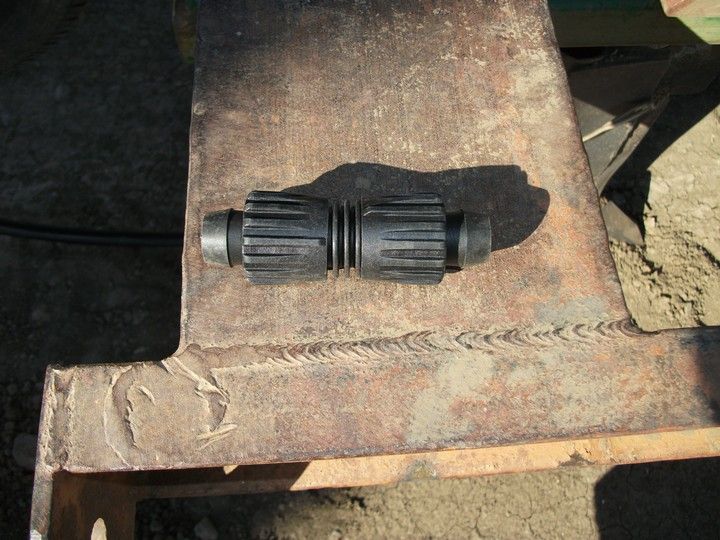You are using an out of date browser. It may not display this or other websites correctly.
You should upgrade or use an alternative browser.
You should upgrade or use an alternative browser.
Typical Day In My Back Yard
- Thread starter usedto
- Start date
Fascinating! So, is that just laid black hose porous, or perforated?
usedto
Lunatic Member
Fascinating! So, is that just laid black hose porous, or perforated?
Neither. It's a feeder line. They will tap into the hose and run small sprinklers off of it.
Last edited:
I was wondering about that. I'm not a total newb when it comes to drip irrigation, and I was trying to figure out how they would insert the sprinkler/drip lines after they buried the first line?
usedto
Lunatic Member
I was wondering about that. I'm not a total newb when it comes to drip irrigation, and I was trying to figure out how they would insert the sprinkler/drip lines after they buried the first line?
I'm like you - this is totally different that what I'm used to. I'll talk to the owner, and I'll pass along the info. Otherwise, we just wait and see.
Last edited:
Perfect! :thmbsp:
usedto
Lunatic Member
Just spoke with Bob, the farmer who is doing this project. He confirmed/corrected some of the information where I had speculated or was wrong, so I went back and edited some of my posts. All in all, I've been pretty accurate about the process.
We walk a mile every morning, and to day was the first day in the 26 years we've been here that we could walk unimpeded from my office to Banta road and back in one straight line. It's almost exactly 1/2 mile each way. Even Max likes the new territory.
We walk a mile every morning, and to day was the first day in the 26 years we've been here that we could walk unimpeded from my office to Banta road and back in one straight line. It's almost exactly 1/2 mile each way. Even Max likes the new territory.
Last edited:
usedto
Lunatic Member
Things are still busy. Here are two of the guys going through the field with shovels:

There 4 sub-main lines in the field, and 193 rows. Everywhere the sprinkler tube crosses the line, there was a riser (in a previous photo). These guys are digging out the tube where they meet the riser all 772 of them. Then, someone comes along, cuts the tube, and attaches it to the riser. This one happens to be next to a cleanout. The small piece laying there is the section they cut out. Alot of the "excess" gets tossed in the trenches and buried.:
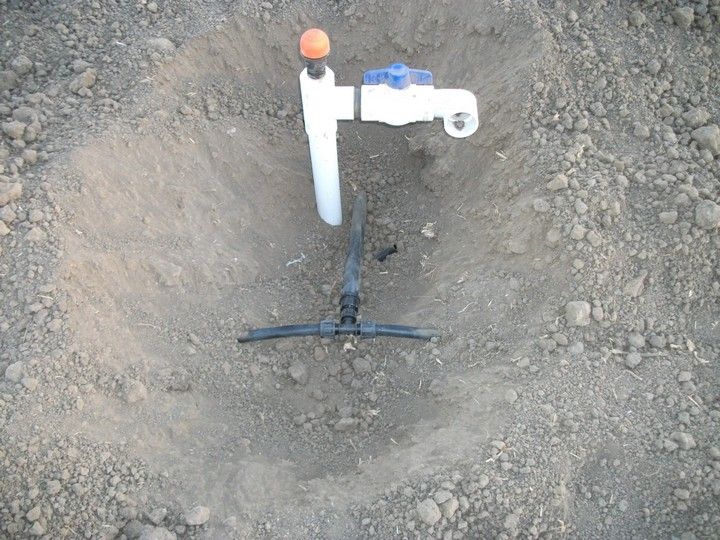
One of the local irrigation district's pipelines ends across the road from this box. Years ago, they would sell some of their excess water to the farmer. He had a pipeline dug under the road to accommodate the water. That arrangement eventually ended, but in lieu of drilling a new well to replace the one that collapsed, they are going to join the district and buy the water from them again. Here is where the water comes in. There is a valve in the bottom of the concrete box, and the the concrete standpipe is also a vent, I'm not quite sure of the new PVC pipe that they have added - it may be a new supply line to take the water to the pressure pump.
Update: The ranch foreman just stopped in my office and educated me. The PVC standpipe they added is a safety. There is a pipeline that runs to the south end of the field where the old well was. When you get district water, you get it - period. There is no stopping it in an emergency. If the electricity fails and quits pumping, water would keep coming from the district, overflow this box, and run downhill to the driveway and house - not good. With this safety, the water will overflow into the pipeline and back up to the south end of the field. If it floods there, there will be no major harm.
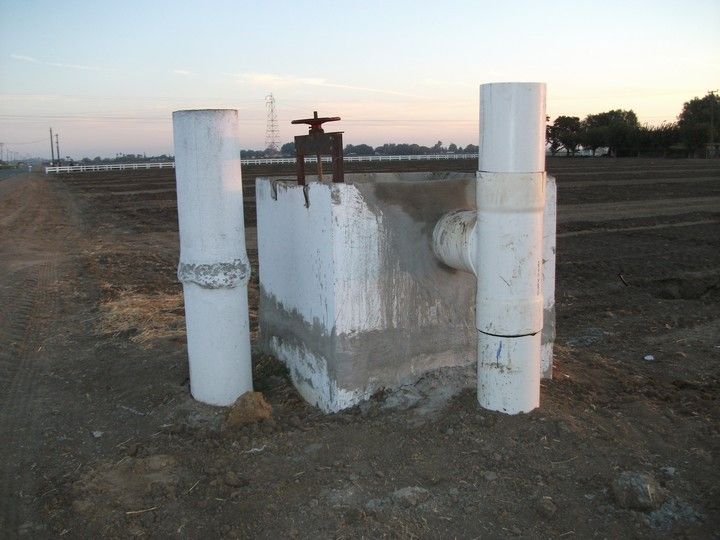
Here is a shot across the road where the pipeline comes from:

And here's the pumping station. If you look on the far left just at the top of the fence, you can see the standpipe from the previous photo. It will feed this system, as well as the well pump on the right (the round white thing with the blue cap).
Update: That square gizmo sticking up out of the concrete box is a trash screen. It's a motorized conveyor, and will trap trash from the district water and convey to the top and over the edge to that metal tray underneath.

Irrigation districts only provide water during the growing season - generally from March until October or so - as long as there are enough using water to make it worthwhile. Problem is, Almonds need something for frost protection during the bloom - usually in February. Since there's no district water then, something else is needed. Most orchards use their sprinklers systems if the have them. They don't have to operate at full volume - just enough to put water out there and raise the temperature for a few hours. That's why this well is tied in. By switching valves, they can use the well water instead of district water. The well pump puts out volume but no pressure, so it has to feed the pressure pump (that round black gizmo in the center). Those long blue tubes are filters, and the white PVC pipes coming out of them are for flushing them out.
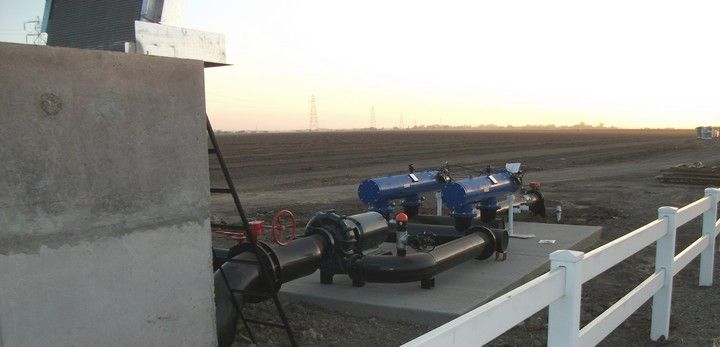
So that's the update for now. One more photo. When we got to the far end of the field, the sun was just coming up, and wifey told me to take a photo. Our house and shop are directly under the sun, so you can't see them. Part of the house is behind that row of Italian Cypress. You can also see the cell tower just to the left of the sun that sits on the edge of my property.
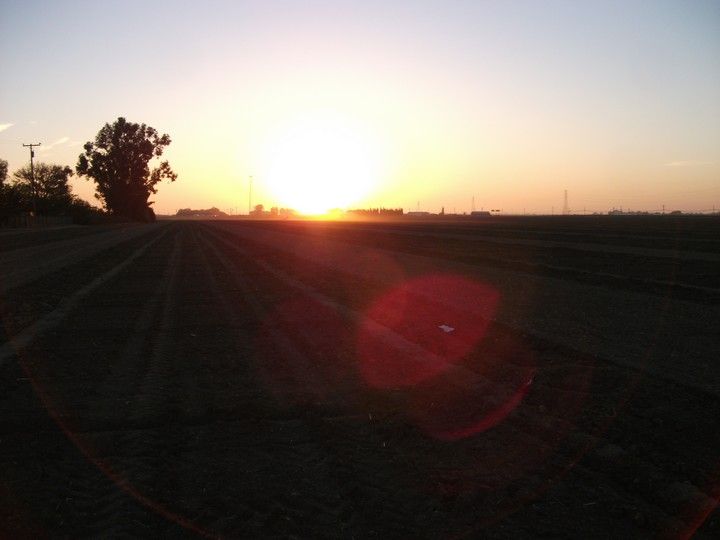

There 4 sub-main lines in the field, and 193 rows. Everywhere the sprinkler tube crosses the line, there was a riser (in a previous photo). These guys are digging out the tube where they meet the riser all 772 of them. Then, someone comes along, cuts the tube, and attaches it to the riser. This one happens to be next to a cleanout. The small piece laying there is the section they cut out. Alot of the "excess" gets tossed in the trenches and buried.:

One of the local irrigation district's pipelines ends across the road from this box. Years ago, they would sell some of their excess water to the farmer. He had a pipeline dug under the road to accommodate the water. That arrangement eventually ended, but in lieu of drilling a new well to replace the one that collapsed, they are going to join the district and buy the water from them again. Here is where the water comes in. There is a valve in the bottom of the concrete box, and the the concrete standpipe is also a vent, I'm not quite sure of the new PVC pipe that they have added - it may be a new supply line to take the water to the pressure pump.
Update: The ranch foreman just stopped in my office and educated me. The PVC standpipe they added is a safety. There is a pipeline that runs to the south end of the field where the old well was. When you get district water, you get it - period. There is no stopping it in an emergency. If the electricity fails and quits pumping, water would keep coming from the district, overflow this box, and run downhill to the driveway and house - not good. With this safety, the water will overflow into the pipeline and back up to the south end of the field. If it floods there, there will be no major harm.

Here is a shot across the road where the pipeline comes from:

And here's the pumping station. If you look on the far left just at the top of the fence, you can see the standpipe from the previous photo. It will feed this system, as well as the well pump on the right (the round white thing with the blue cap).
Update: That square gizmo sticking up out of the concrete box is a trash screen. It's a motorized conveyor, and will trap trash from the district water and convey to the top and over the edge to that metal tray underneath.

Irrigation districts only provide water during the growing season - generally from March until October or so - as long as there are enough using water to make it worthwhile. Problem is, Almonds need something for frost protection during the bloom - usually in February. Since there's no district water then, something else is needed. Most orchards use their sprinklers systems if the have them. They don't have to operate at full volume - just enough to put water out there and raise the temperature for a few hours. That's why this well is tied in. By switching valves, they can use the well water instead of district water. The well pump puts out volume but no pressure, so it has to feed the pressure pump (that round black gizmo in the center). Those long blue tubes are filters, and the white PVC pipes coming out of them are for flushing them out.

So that's the update for now. One more photo. When we got to the far end of the field, the sun was just coming up, and wifey told me to take a photo. Our house and shop are directly under the sun, so you can't see them. Part of the house is behind that row of Italian Cypress. You can also see the cell tower just to the left of the sun that sits on the edge of my property.

Last edited:
usedto
Lunatic Member
Still no new activity in the field. If we ever get any rain, they're going to spread some gyp and fertilizer to get them watered into the ground prior to planting.
Thought I'd show you this, since I mentioned the hardpan that might be lurking underground. We went out to the home ranch Sunday for our quarterly meeting, so I took a photo of what some serious hardpan looks like. This was hauled out of one of our fields. It lurks underground in slabs just like concrete, and you have to break it up to get good root systems to form. Gyp helps break it up.
That's my older sister's vineyard behind the pile, my brother's almonds behind that vineyard, my younger sister's vineyard to the right across the road, and my almonds beyond that.
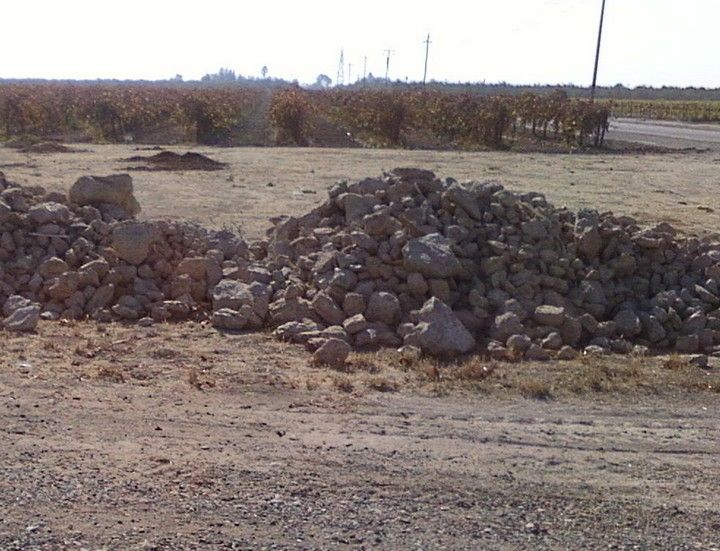
Thought I'd show you this, since I mentioned the hardpan that might be lurking underground. We went out to the home ranch Sunday for our quarterly meeting, so I took a photo of what some serious hardpan looks like. This was hauled out of one of our fields. It lurks underground in slabs just like concrete, and you have to break it up to get good root systems to form. Gyp helps break it up.
That's my older sister's vineyard behind the pile, my brother's almonds behind that vineyard, my younger sister's vineyard to the right across the road, and my almonds beyond that.

my guess - water carries it deep enough and chemical reactions do the work.
usedto
Lunatic Member
Is that why the gypsum is to be spread? How does it get worked in deep enough to be beneficial?
my guess - water carries it deep enough and chemical reactions do the work.
Right you are. They spread on the top of the ground, then wait for the rain (or irrigation) to take it down. When they do this orchard-to-be, I'll take photos.
usedto
Lunatic Member
Since the trees won't be planted until after the first of the year, they put on a combination of gyp and fertilizer in strips. They pile the mixture at the end of the field (you can see it up in front of the tractor), then use a front loader to dump it in the spreader. The spinners are turned off on the spreader so the material just falls in strips - in the holes and between the trees. As you can see by the sky, they did it just before rain.


usedto
Lunatic Member
Here's a little added info:
This orchard was planted across the road last year by the same farmer. We're having a slight cold spell, and last night they turned on the sprinklers to help protect the young trees. Since there are no blossoms, it may have just been a test also. Anyways, it made quite a spectacle. There have been hundreds of cars stop along side a VERY busy road (used to be HWY 50) to take pictures. I just walked out there.
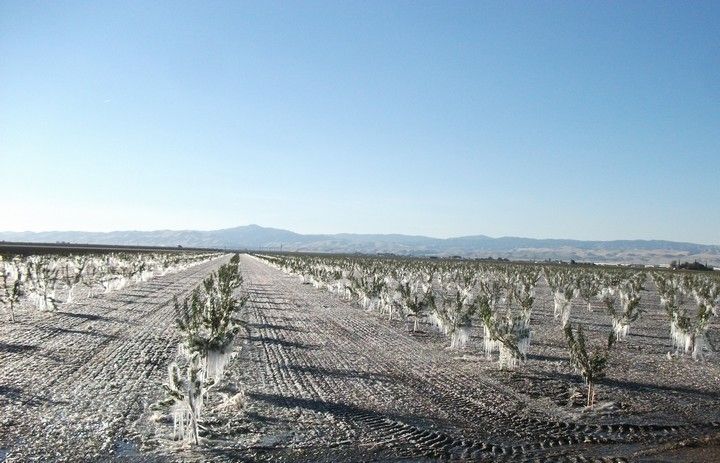

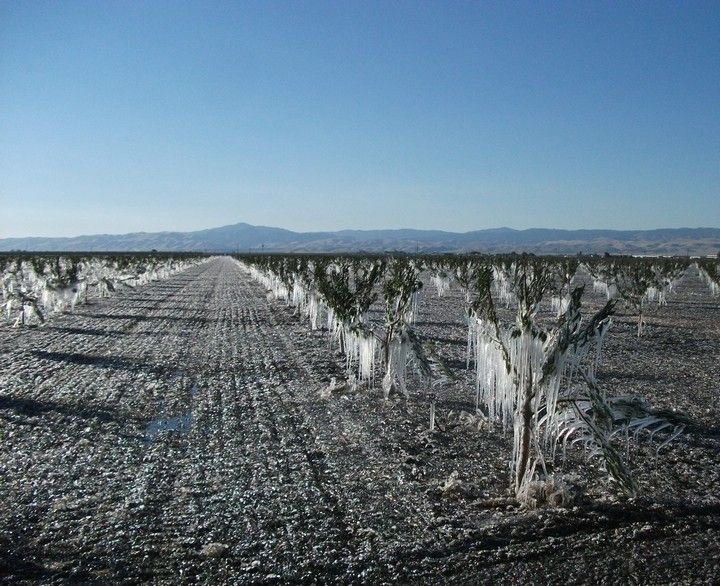

You can see the stream of water coming out of the sprinkler in the last photo just left of the tree.
This orchard was planted across the road last year by the same farmer. We're having a slight cold spell, and last night they turned on the sprinklers to help protect the young trees. Since there are no blossoms, it may have just been a test also. Anyways, it made quite a spectacle. There have been hundreds of cars stop along side a VERY busy road (used to be HWY 50) to take pictures. I just walked out there.




You can see the stream of water coming out of the sprinkler in the last photo just left of the tree.
usedto
Lunatic Member
Well, it seems Mother Nature has sped up the process a bit. You want to plant the trees when dormant, and the last week or two of temps in the 20s has taken care of that, so in the ground they go. There are 4 or 5 rigs with trailers going through the field dropping the trees in the holes. You can see another in the background:
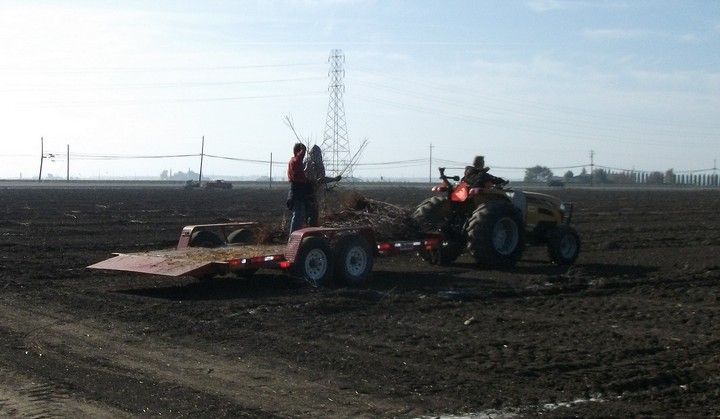
Here they are, ready to be covered:

There is a crew coming through the field standing them up and backfilling the holes. I'll try to get a photo when they get closer to me.

Here they are, ready to be covered:

There is a crew coming through the field standing them up and backfilling the holes. I'll try to get a photo when they get closer to me.
usedto
Lunatic Member
Here are two of the planters. One takes the tree and sets it in the hole while the other backfills partially. Then, the holder will pull up on the tree to raise the graft above surface level and get the roots pointing down. They also lean the trees slightly Northwest into the predominant wind. The rest of the dirt is filled in, then lightly packed by foot.

And the not-quite finished product:
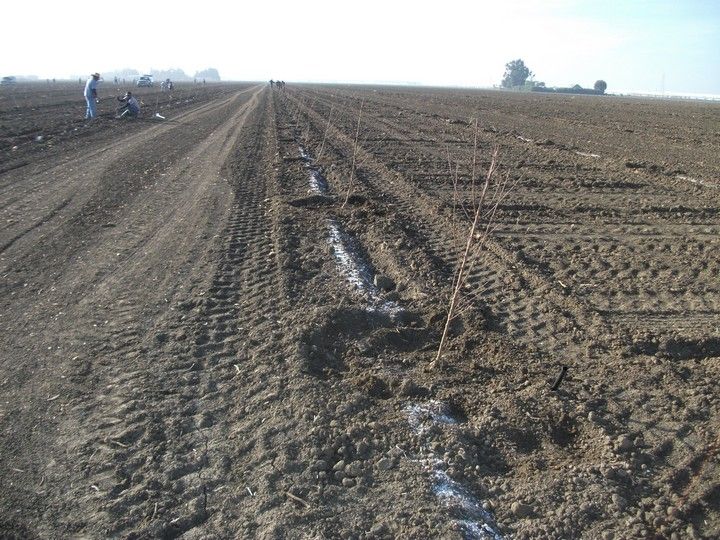
Still some work to do. Will keep you posted.

And the not-quite finished product:

Still some work to do. Will keep you posted.
usedto
Lunatic Member
A bit more info:
I mentioned the graft in the post above above. Almonds by nature are bitter. If you ever eat an almond grown from seed, you'll understand.
These trees are almond stock grafted onto [usually] peach or plum rootstock to get the sweetness in the nuts.
Almonds usually need pollinators to get a crop. Nonpareil are the most common variety, but must have a pollinator to produce a crop. That also means bees need to be brought into orchards to do their thing. Our bill for bees for around 100 acres last year was just under $30,000 for the blossom season. And, different varieties ripen at different times, making harvest a two or three part deal.
These trees planted here are a new variety invented here in California called "Independence", which can self-pollinate. Here in windy Tracy should work just fine. The jury is still out as to whether or not they need bees to 'help out', but their popularity is growing. One variety, one harvest. Makes it nice.
I mentioned the graft in the post above above. Almonds by nature are bitter. If you ever eat an almond grown from seed, you'll understand.
These trees are almond stock grafted onto [usually] peach or plum rootstock to get the sweetness in the nuts.
Almonds usually need pollinators to get a crop. Nonpareil are the most common variety, but must have a pollinator to produce a crop. That also means bees need to be brought into orchards to do their thing. Our bill for bees for around 100 acres last year was just under $30,000 for the blossom season. And, different varieties ripen at different times, making harvest a two or three part deal.
These trees planted here are a new variety invented here in California called "Independence", which can self-pollinate. Here in windy Tracy should work just fine. The jury is still out as to whether or not they need bees to 'help out', but their popularity is growing. One variety, one harvest. Makes it nice.



